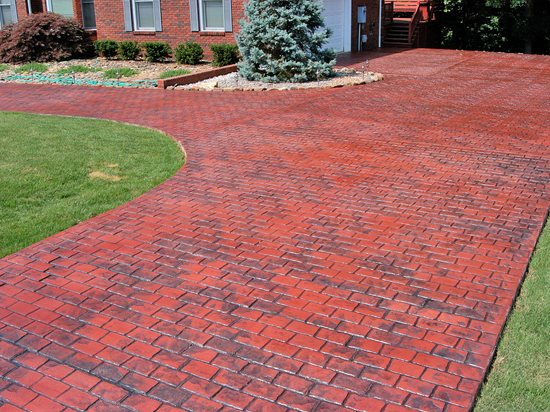- Concrete Overlays Home
- Get the Look - Interior Overlay Pictures
- When to Use a Polymer Overlay
- Comparison Chart of Overlay Systems: Which is best for your project?
- Five Factors to Consider when Choosing a Resurfacing System
- Concrete Overlay Reviews
- Types of Overlays
- Epoxy Coatings
- Microtoppings & Skim Coats
- Self-Leveling Overlays
- Spray-Down Toppings
- Polishable Overlays
- Stamped Concrete Overlays
- Preparing Concrete for Resurfacing
- Concrete Resurfacing
- Reducing Bond Failures Caused by Moisture-Vapor Transmission
- Don't Let Water Vapor Delaminate Your Overlay: How to seal concrete before an overlay
- How-To Tips for Installing Concrete Overlays
- Answers to Common Questions About Concrete Overlays: Advice from expert Chris Sullivan
- How to Add Color to Concrete Overlays
- How to Protect and Maintain Resurfaced Concrete
- Overlay Tools: Seven essential tools for concrete resurfacing
- Related Information
- Concrete Overlay Videos, with Bob Harris
- Decorative Concrete Overlays: A primer of the various overlay types and the decorative possibilities with each
- Vertical Concrete Overlays: Lightweight cement-based overlays mimic stone, brick, and other wall textures
Multipurpose Overlay Mix Offers Ultimate Flexibility
Whether you want to overlay horizontal or vertical concrete surfaces, indoors or out, Smith Paint’s 4-in-1 overlay mix can do it all. The single-component dry mix comes ready-to-use in 50-pound bags and is simply mixed onsite with water at the desired ratio, depending on your choice of application method. You can apply the product as a stamped overlay, spray texture, or hand-troweled horizontal or vertical surface. A high level of polymer modification allows you to adjust the water-to-mix ratio to accommodate the application method, specific substrate, weather conditions and other jobsite variables.
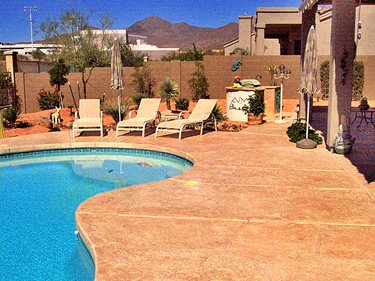
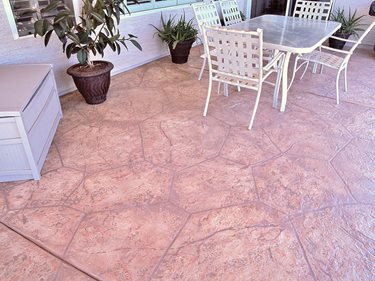
Smith Paint’s 4-in-1 overlay mix can be used on outdoor surfaces. Photos courtesy of Artistic Polymers Inc.
“Smith’s 4-in-1 formulation has a custom blend of components, giving it superior workability, bond strength, impact resistance and wear life,” says Chuck Brunner Jr. of Smith Paints. The overlay can be applied directly over properly prepared substrates. The high bond strength eliminates the need for a separate bond coat.
Product ApplicationsThe potential uses for Smith’s 4-in-1 are broad, ranging from driveways to residential flooring and walls to countertops. The overlay also has heat-reduction characteristics, making it ideal for pool decks and patios. “A unique blend of aggregate components reduce the density of the installed material as compared to concrete, which reduces the heat retention on the surface,” says Brunner.
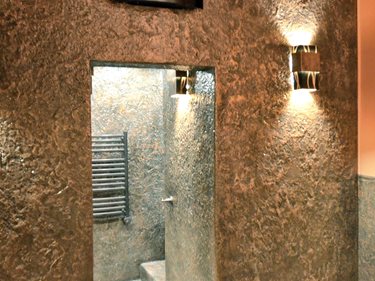
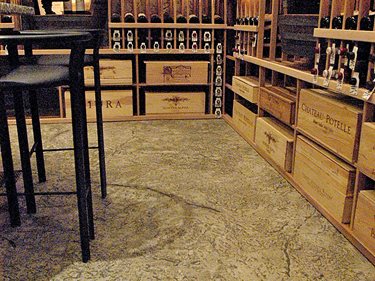
Smith’s overlay mix can also be used indoors and on vertical surfaces. Photos courtesy of Artistic Polymers Inc.
A multitude of decorative effects are also possible, including stamped patterns, textured wall surfaces, and integral or topically applied color. Smith offers 16 colors of dry pigment that can be added directly to the mix. Or the overlay can be colored after placement with Smith’s Color Floor and Color Wall water-based stains, acid stains, water- or solvent-based dyes, and acrylic paints.
After the overlay is applied, it can be stamped soon after then stained or sealed 12 hours later. Brunner recommends sealing the overlay with Smith’s Royal Seal, Smith’s Polyurethane, a water- or solvent-based polyurethane. However, the sealer choice can be modified to accommodate specific project requirements.
The coverage rate for one bag of Smith’s 4-in-1 mix ranges from 20 to 30 square feet for a ¼- to ½-inch stamp coat to 125 to 150 square feet for a spray-on texture. Simply combine the dry mix and the appropriate amount of water in a 5-gallon pail and blend with a drill fitted with a ½-inch mortar mixing paddle.
For more information:
Smith Paints - Harrisburg, Pa.
717-233-8781
Return to Decorative Concrete Overlays
 Rapid Set Skim Coat
Repairs, levels, and smooths concrete for applications.
Rapid Set Skim Coat
Repairs, levels, and smooths concrete for applications.
 Thin Micro-Topping
Produces durable surface to color or stain
Thin Micro-Topping
Produces durable surface to color or stain
 Self Leveling Overlay
Find the overlay to meet your project's needs
Self Leveling Overlay
Find the overlay to meet your project's needs
 T1000 Stampable Overlay
For use with resurfacing concrete floors and hardscapes.
T1000 Stampable Overlay
For use with resurfacing concrete floors and hardscapes.
 Kemiko® Buildable Overlay
Decorative interior or exterior resurfacing
Kemiko® Buildable Overlay
Decorative interior or exterior resurfacing
 Flooring & Coating System
Epoxy Flooring System designed for concrete
Flooring & Coating System
Epoxy Flooring System designed for concrete
 Stamped Concrete Overlay
Warm weather and cold weather formulas
Stamped Concrete Overlay
Warm weather and cold weather formulas
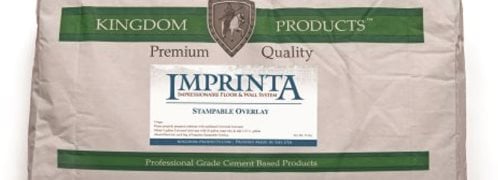 Imprinta Stampable Overlay
2-component system
Imprinta Stampable Overlay
2-component system
